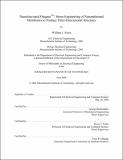| dc.contributor.advisor | George Barbastathis and Henry I. Smith. | en_US |
| dc.contributor.author | Arora, William Jay | en_US |
| dc.contributor.other | Massachusetts Institute of Technology. Dept. of Electrical Engineering and Computer Science. | en_US |
| dc.date.accessioned | 2009-03-20T19:31:23Z | |
| dc.date.available | 2009-03-20T19:31:23Z | |
| dc.date.copyright | 2008 | en_US |
| dc.date.issued | 2008 | en_US |
| dc.identifier.uri | http://hdl.handle.net/1721.1/44911 | |
| dc.description | Thesis (Ph. D.)--Massachusetts Institute of Technology, Dept. of Electrical Engineering and Computer Science, 2008. | en_US |
| dc.description | This electronic version was submitted by the student author. The certified thesis is available in the Institute Archives and Special Collections. | en_US |
| dc.description | Includes bibliographical references (p. 123-127). | en_US |
| dc.description.abstract | Microdevice fabrication is done on the surface of polished flat semiconductor substrates with a series of material depositions, etches and lithography steps. These processes are inherently planar and well suited for the fabrication of billions of micrometer-thick transistors over 300 mm diameter substrates, but impractical for building vertically. This thesis presents a method of building three-dimensionally (3D) with existing planar fabrication technology: fabricate on a thin membrane, and then fold the membrane into a 3D structure. Material stresses patterned on a membrane will cause controlled bending. A simple demonstration is the bilayer, in which a stressed metal is deposited on a stress-free membrane. One challenge with this approach is to achieve very small fold radii for tight 3D packing. The solution presented here is helium ion implantation into the membrane, which creates a large localized stress that is capable of bending a 100 nm thick membrane around a 1 [mu]m radius without fracturing it. The energy and dose of the helium ions control the direction and angle of the fold, which is explained within a theoretical framework, and shown to agree with experiment. One application of stress-folding is a chemical sensor. Built as a 3D micro-switch, the stress that develops in a reactive polymer bends the switch closed. Results show that it operates with negligible power consumption and selectively responds to a target analyte with more than a million-fold electrical resistance change. Other applications discussed include a 3D inductor and non-periodic artificial dielectrics made by membrane folding combined with new 3D optical patterning and magnetic self-alignment techniques. These practical advances open the way to designing a variety of 3D devices which may have broad applications in computing, communications and detection. | en_US |
| dc.description.statementofresponsibility | by William J. Arora. | en_US |
| dc.format.extent | 127 p. | en_US |
| dc.language.iso | eng | en_US |
| dc.publisher | Massachusetts Institute of Technology | en_US |
| dc.rights | M.I.T. theses are protected by
copyright. They may be viewed from this source for any purpose, but
reproduction or distribution in any format is prohibited without written
permission. See provided URL for inquiries about permission. | en_US |
| dc.rights.uri | http://dspace.mit.edu/handle/1721.1/7582 | en_US |
| dc.subject | Electrical Engineering and Computer Science. | en_US |
| dc.title | Nanostructured Origami (TM) : stress-engineering of nanopatterned membranes to produce three-dimensional structures | en_US |
| dc.title.alternative | Stress-engineering of nanopatterned membranes to produce three-dimensional structures | en_US |
| dc.type | Thesis | en_US |
| dc.description.degree | Ph.D. | en_US |
| dc.contributor.department | Massachusetts Institute of Technology. Department of Electrical Engineering and Computer Science | |
| dc.identifier.oclc | 298553357 | en_US |
